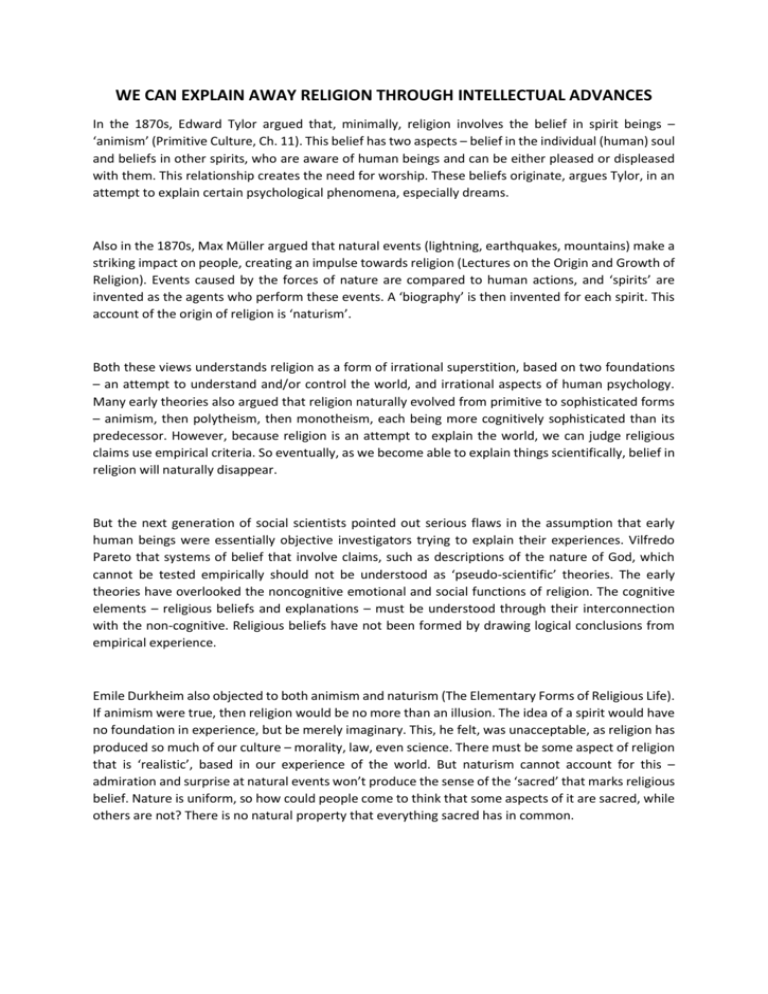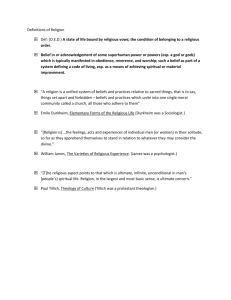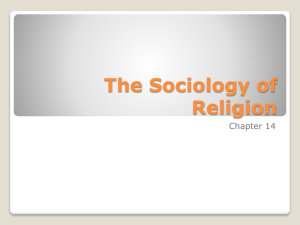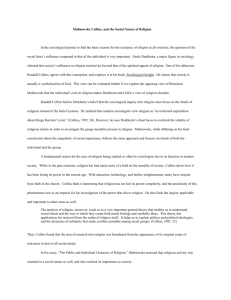File - PJW RE
advertisement

WE CAN EXPLAIN AWAY RELIGION THROUGH INTELLECTUAL ADVANCES In the 1870s, Edward Tylor argued that, minimally, religion involves the belief in spirit beings – ‘animism’ (Primitive Culture, Ch. 11). This belief has two aspects – belief in the individual (human) soul and beliefs in other spirits, who are aware of human beings and can be either pleased or displeased with them. This relationship creates the need for worship. These beliefs originate, argues Tylor, in an attempt to explain certain psychological phenomena, especially dreams. Also in the 1870s, Max Müller argued that natural events (lightning, earthquakes, mountains) make a striking impact on people, creating an impulse towards religion (Lectures on the Origin and Growth of Religion). Events caused by the forces of nature are compared to human actions, and ‘spirits’ are invented as the agents who perform these events. A ‘biography’ is then invented for each spirit. This account of the origin of religion is ‘naturism’. Both these views understands religion as a form of irrational superstition, based on two foundations – an attempt to understand and/or control the world, and irrational aspects of human psychology. Many early theories also argued that religion naturally evolved from primitive to sophisticated forms – animism, then polytheism, then monotheism, each being more cognitively sophisticated than its predecessor. However, because religion is an attempt to explain the world, we can judge religious claims use empirical criteria. So eventually, as we become able to explain things scientifically, belief in religion will naturally disappear. But the next generation of social scientists pointed out serious flaws in the assumption that early human beings were essentially objective investigators trying to explain their experiences. Vilfredo Pareto that systems of belief that involve claims, such as descriptions of the nature of God, which cannot be tested empirically should not be understood as ‘pseudo-scientific’ theories. The early theories have overlooked the noncognitive emotional and social functions of religion. The cognitive elements – religious beliefs and explanations – must be understood through their interconnection with the non-cognitive. Religious beliefs have not been formed by drawing logical conclusions from empirical experience. Emile Durkheim also objected to both animism and naturism (The Elementary Forms of Religious Life). If animism were true, then religion would be no more than an illusion. The idea of a spirit would have no foundation in experience, but be merely imaginary. This, he felt, was unacceptable, as religion has produced so much of our culture – morality, law, even science. There must be some aspect of religion that is ‘realistic’, based in our experience of the world. But naturism cannot account for this – admiration and surprise at natural events won’t produce the sense of the ‘sacred’ that marks religious belief. Nature is uniform, so how could people come to think that some aspects of it are sacred, while others are not? There is no natural property that everything sacred has in common. How true is it to say that religion can be explained away? My LOA: Point Evidence Criticism Rejoinder WE CAN EXPLAIN AWAY RELIGION THROUGH REFERING TO ITS SOCIAL AND EMOTIONAL FUNCTION Malinowski In the 1920s, Bronislaw Malinowski supported the arguments of Pareto, demonstrating that religion is not pseudo-science (‘Magic, Science and Religion’). ‘Primitive’ people do not confuse religious belief with empirical knowledge of how the world is and how to meet their needs. Religion relates to magic, which serves a different purpose, originating in situations in which people aren’t certain of success in getting what they need. Despite their best efforts, e.g. at farming or catching fish, the outcome is uncertain. This combination of strong emotional investment and uncertainty, argued Malinowski, leads to psychological tension and anxiety. (This is his development of Pareto’s idea of the noncognitive elements of religion.) Magical rites emerge, aimed at ensuring success. This has two functions: it helps resolve anxiety and it protects the motivation to keep trying (this motivation could otherwise be defeated by the thought ‘what’s the point?’, which would undermine the survival of society). But magic is not religion. Religious rites and belief relate to anxiety in the face of situations where nothing can be done, e.g. death. The magical rite relates to a definite aim of the performer, the religious rite does not. However, like magic, religion has a useful social function – it contains and formalizes the expression of emotions and attitudes that could otherwise be destructive of the group. Malinowski’s account of the distinction between magic and religion has been questioned, as many religious rites appear to have a definite purpose, and many religious beliefs relate to practical activities (e.g. a famine as punishment for sins). But his overall account shows the importance of the social function of religion. If Malinowski’s account were right, religion would relieve anxiety. But this doesn’t seem to be so. First, the believer feels anxiety about whether the ritual has been performed properly. Anxiety has not been alleviated, but at best, displaced. However, we should note that religions contain further rituals relating to this, viz. to do with the purification and expiation of sins. Nevertheless, we can still object that even in this complicated form, the analysis of religion remains too optimistic. Over time, religion has produced as much anxiety, e.g. about how to live and the effects of our actions on an afterlife, as it has alleviated. This is not to deny that religion has something to do with the experiences Malinowski discusses, but it rejects the claim that its (sole) function is alleviate anxiety. How true is it to say that religion can be explained away? My LOA: Point Evidence Criticism Rejoinder WE CAN EXPLAIN AWAY RELIGION THROUGH REFERING TO ITS SOCIAL AND EMOTIONAL FUNCTION Durkheim Durkheim identifies two defining aspects of religion First, all religions are marked by the division of the world into what is sacred and what is not (not sacred = profane). Sacred things are set apart and forbidden from common use, while rites are rules on how to behave towards what is sacred. Second, all religions involve a group, a ‘church’ – individuals understand themselves united by their faith, becoming a ‘moral community’. This contrasts with magic, which doesn’t generate a sense of unity. At the heart of religion, then, is a set of attitudes: the sacred deserves respect, and it is associated with authority and morality. This again demonstrates that we cannot understand religion as logical inferences from empirical experiences. As we saw above, Durkheim argued that this attitude cannot derive from animism or naturism. Instead, the original and simplest form of religion, he argued, is totemism. Human society was originally organized, he claimed, by clan. Members of the clan felt their bond to each other as very special, and not merely biological. Each clan had a totem, which was shared with no other clan. The totem was the paradigmatically sacred thing – everything sacred was sacred through some connection with the totem. The totem represented something impersonal, of which it was merely a symbol – the first ‘religious’ symbol, a symbol of authority, morality, and divinity. And yet the totem also represents the clan, society. So society itself is the origin of religion and the idea of god. In the totem, argues Durkheim, society has deified itself. Society holds the authority and moral code that is expressed through religion. It is vastly superior in power to the individual, and the individual is utterly dependent on it. Furthermore, society imposes behaviour that will serve its ends and requires sacrifices of the individual; it imposes its values, without which social life would be impossible. Religious rites express forces that impose morality, bond society together, and support and celebrate life. Durkheim’s views on the social functions of religion, and the close tie between religion, morality and authority, have been widely accepted. However, that the totem expresses both god and society is, on its own, insufficient for Durkheim’s conclusion that society has effectively become its own god. How true is it to say that religion can be explained away? My LOA: Point Evidence Criticism Rejoinder WE CAN EXPLAIN AWAY RELIGION THROUGH REFERING TO THE PROBLEM OF MEANING There are different religions, with different religious beliefs and practices. Nothing in the theories discussed addresses this issue. If the only function of all religion is to alleviate anxiety or create social bonds, then any differences between religions must either be considered unimportant or be explained in similar terms, e.g. as responses to what was required for a particular society at a particular time to function well. In the 1920s, Max Weber argued that we can only explain religious beliefs if we refer to people’s attempts to think about and solve the issues that religion tackles (The Protestant Ethic and the Spirit of Capitalism). The emotion-based accounts that Malinowski and Durkheim present are not wrong, but religion also has a cognitive dimension, which we can call ‘the problem of meaning’. Talcott Parsons (‘Sociology and Social Psychology’) defines religion as a response to those aspects of life that we cannot rationally understand or control, but which nevertheless are felt to relate to fundamental questions about our place in the universe, values and the meaning of life. Frustration and anxiety isn’t just an emotional state – it can also be cognitive. Confronted with cognitive frustration, human thought develops in different directions, and it is this that explains the differences in religious beliefs. These beliefs are integrated with many practical attitudes that people adopt towards everyday life. Religious conviction, for each individual, isn’t created rationally, but as supplying a way of understanding how to behave in certain areas of life where, otherwise, we have no guidance. Bringing together all the theories above, Parsons argues that a religion will minimally contain 1. beliefs about the supernatural or the sacred, including the connection of these to morality; 2. a system of symbols, objects, acts and people which are sacred; 3. a set of activities that are seen as important in the light of religious beliefs, but which don’t try to accomplish anything practical; 4. a group that shares these beliefs, and is united as a group in this way. Clifford Geertz (‘Religion as a cultural system’) argues that we are confronted with this the problem of meaning in three forms: there are limits to our cognitive abilities (explaining the existence and nature of the world), limits to our endurance, especially in illness and death, and limits to our moral insight, esp. the problem of evil. In each case, religion provides an answer, removing the threat of meaninglessness. However, Geertz rejects the claim that (solving) the problem of meaning is the basis of religious belief. These solutions to meaninglessness are not arrived at from experience. Instead, we must already accept some form of religious authority, which transforms our experience through its system of symbols. In engaging in a life informed by religion, the believer develops a distinctive set of dispositions which change his activities and his experiences. Conversely, the individual’s emotions and motivations are made meaningful by being related to the religion, e.g. Christian charity or Christian hope. Religious concepts not only provide a framework for interpreting experience, they shape experiences. Many religions claim that we must believe before we can know. How true is it to say that religion can be explained away? My LOA: Point Evidence Criticism Rejoinder









